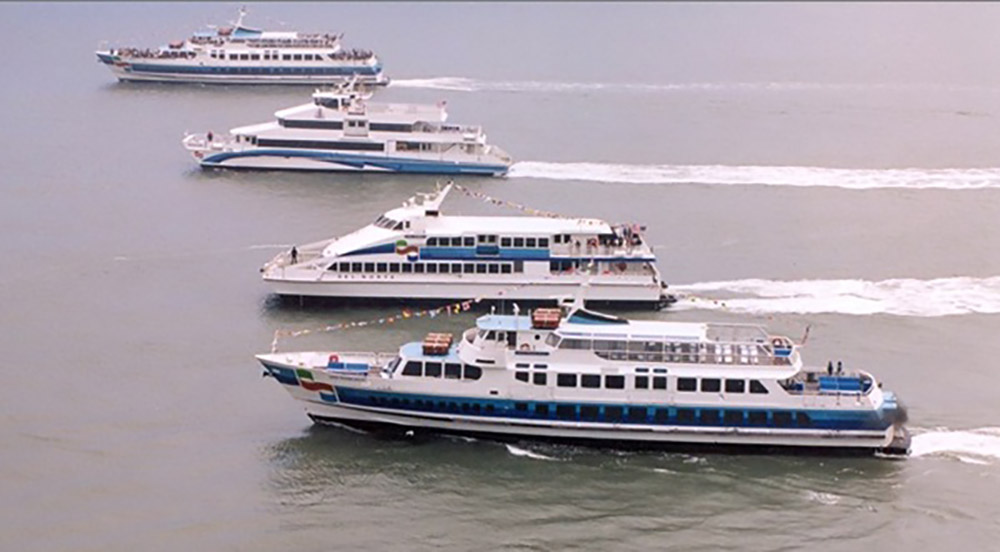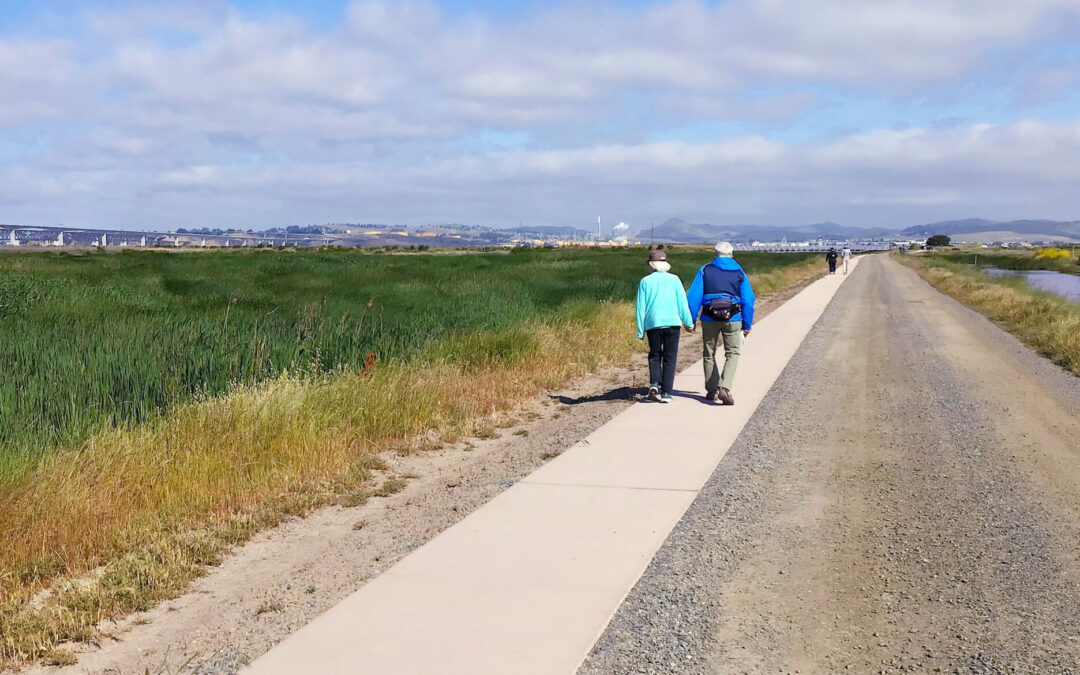Despite its pro-environment history, the Golden Gate District is resisting ferry electrification, frustrating advocates for a zero-emission fleet.


Despite its pro-environment history, the Golden Gate District is resisting ferry electrification, frustrating advocates for a zero-emission fleet.

We tour Pacheco Marsh, a once-rough patch of Bay shoreline that is now a green refuge for walkers, birds, and even paddleboarders.

A $322M grant powers Oakland’s port electrification — cleaning air, cutting emissions, and investing in community justice.
All Stories
Even though Dan Hoover’s been surveying the same stretch of San Francisco’s Pacific coast for 15 years on his ATV, it never looks the same. In summer it’s wider and in winter narrower. With El Niño the beach will erode more than ever.
Can tides and waves move sediment placed in the shallows onto wetlands? The Army Corps is experimenting with how to do it.
With climate change, forests across California seem doomed to retreat, but maybe not everywhere. In at least one coastal county, there’s hope of keeping valued woodlands healthy, provided past mistakes can be corrected, fast.
San Francisco’s new Environment Department director, Tyrone Jue, aims to help his city achieve net zero emissions by 2040.
Like Russian dolls, Bay Area preparations for sea level rise finally began fitting together this fall.
After a car crash, Janet Byron switched to an e-bike. Now she is a bike evangelist — and the City of El Cerrito is listening
Weathering climate disasters requires more than packing a small go-bag. State planners say real resilience is rooted in connecting with your neighbors.
As climate hazards multiply, Bay Area communities, local governments, and agencies are searching for ways to address them more holistically.
Marta Segura, California’s first Chief Heat Officer, talks with KneeDeep Times about making extreme heat a priority in Los Angeles.
Ten months after the Port of San Francisco lowered 288 experimental tiles into the water, these bio-friendly seawall surfaces are already crawling with crabs and covered in kelp. This August, researchers are finally getting a good look at all the tile types in their experiment, which range from large to small, and from bumpy to smooth, and which were hung from the waterfront at three different locations and tidal elevations in October 2022.
Imagine a Mad Max-style wasteland, ravaged by wildfire, but populated by frolicking woodland fauna. That’s what Kendall Calhoun was surprised to see just months after one of California’s biggest megafires.
The Bay Area’s mild weather is a liability for its residents in the face of growing heat risks from temperature swings to hotter nights. But what exactly makes the heat linger?
Regional agencies made splashy headlines when they released a joint study on the likely cost of protecting Bay Area shores from rising seas: $110 billion. But the top-line number didn’t offer much insight into the complexities. A new inventory and map from the same agencies is much more revealing.
You’re on the bus. It’s your evening commute. The bus is almost full. Soft waves of chatter wash over you as you watch the blurred lights of storefronts pass by.
When it rained this May, it felt unexpected. Based on over 150 years of climate data for San Francisco, May typically gets several days with a light rain. But context is key, and we are coming out of three years of drought—a fact which will generally color memories in a drier hue. “If I’ve learned anything it is that people’s perceptions are usually wrong,” says Jan Null….
In San Mateo County, new planning guidance may help cities account for rising seas when approving new developments. OneShoreline’s proposals are stricter than current requirements from federal, state, and local agencies, but those are also evolving. “The intent is to go where we already see regulators are going,” says Makena Wong, a project manager.
The region is obsessing over beach-building. Whether it’s a degraded salt marsh in downtown San Rafael or a sliver of wetlands near the old San Francisco shipyards, local practitioners are adding beaches as nature-based buffers against waves and rising seas to adaptation projects around the Bay.
33 Fruitvale homes in Oakland could look forward to improved air quality, lowered water usage, greener energy and an innovation in the local energy system called a microgrid through a project called EcoBlock.
A new public art installation, called Fencelines, redefines the only barrier separating Richmond’s residential neighborhoods from the Chevron oil refinery: a wire fence.
Debbie Harris directs Urban Adamah, a Jewish urban farm in Northwest Berkeley. She is a farmer by trade but her role at Urban Adamah requires her to be “a horticulturalist, a plumber, a therapist, a teacher, an organizer.”
This spring, Sustainable Solano hosted open gardens that they helped plan and plant, offering visitors a chance to discover these food forests: a garden layered like a natural forest that includes fruit-bearing trees and edible plants.
In this photo essay, Megan King captures the Coyote Creek watershed swollen with water after winter storms. Last year, she explored something completely different: drought.
Coastal erosion in Pacifica, drought in Brentwood, fires in the North Bay, flooding in Union City, and urban heat in San Jose. Anissa Foster takes us on a revealing virtual tour.
Climate change has a disproportionate impact on incarcerated Americans. Juan Moreno Haines, one of 2.3 million prisoners in the US, describes his experience.
Oona Khan dreams about her home of the future, after losing her Malibu retreat to fire. Caught in a quagmire of legal battles with Southern California Edison, and surging construction costs, Khan is still waiting to start construction.
On a clear morning in January, a group of tide worshippers gathered at the Santa Monica Pier to “celebrate the ocean and build our climate community,” said Laurene von Klan.
Research confirms the drastic impacts wildfire smoke has had on school learning. But 16 East Bay schools now have updated air filters and more actions are in the pipeline statewide.
When we fled the house in the Santa Cruz mountains that we had been living in for just nine months, we knew exactly two of our neighbors.
Typical flood protections rely on engineered structures. But there’s a new push at the national level of the US Army Corps of Engineers to prioritize working with nature. Storm surge plans currently underway in New York, Miami and San Francisco highlight a range of nature-based fixes.
In November 2022 San Rafael launched a resilience planning project that has community-based organizations playing an active role in decision-making.
The 14 graduates of the inaugural 2021 Oakland Shoreline Leadership Academy have new skills to confront the rising tide head-on. “It’s completely changed how I look at the environment,” confesses Academy alum Shy Walker.
San Francisco is increasingly seen as a “green” city but its track record doesn’t hold up under scrutiny.
Grimes and Belvedere were the only two northern California towns that FEMA shortlisted this year for flood prevention funding. But flood protection is often more easily planned than done.
A plan to protect SFO could become a critical link in a chain of resilience projects along the San Mateo County bayshore. But projects that cross jurisdictional borders, get complicated.
When he purchased a house, Ever Rodriguez noticed how North Fair Oaks differed from surrounding areas. “We don’t have the same infrastructure or services as in Menlo Park.”
This fall, Sonoma County officially enlisted its abundance of undeveloped lands in the fight to adapt to climate change. Last month, the county approved a “Climate Resilient Lands” strategy.
Between gasping sobs, a boy in a viral video explains that he’s upset because of climate change. San Mateo county’s education office is trying to help.
Buried in the blueprints for a refurbished San Francisco seawall is a cutting-edge experiment in texturing pieces of this buttress against sea level rise so they attract native species.
An East Palo Alto affordable housing project is at the forefront of a trend cities across California are trying to encourage: switching from natural gas appliances to electric ones. But the transition isn’t without headaches.
Suisun City has been exploring ways to increase its resiliency to sea level rise and storm surges, including updating infrastructure, building an ecotone levee, and holding a resiliency workshop.